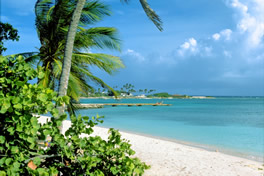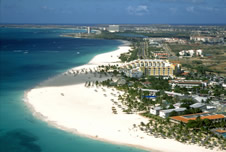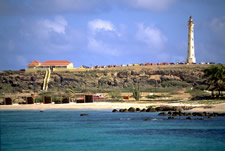
Enjoy Tropical Outdoor Adventures in Sunny Aruba
by
Wendy O'Dea
 |
|
Photo
courtesy of Aruba Tourism Authority | Looking
down I saw a large piece of coral, brown with a white border along its outer edge,
and furiously began flapping my arms, forcing my body upward. My guide had warned
me about the dangers of the sea: not sharks or jellyfish, but fire coral. "It
will burn you," she said, "and ruin the rest of your stay on our sunny
island." Certainly
the last thing I wanted was to ruin my stay on the sunny island of Aruba. Although
a popular destination for east-coasters, I'd traveled quite a distance from California
to get to the tiny island and didn't want to spend my time nursing stinging burns
from an aquatic life form. It
was during my underwater Snuba adventure that I narrowly escaped the fire coral.
You read right, Snuba. An odd combination of snorkeling and Scuba diving, this
sport encompasses much of the fun of Scuba without the hassles. Rather than donning
a heavy tank of oxygen, a breathing apparatus is tethered to a tank floating on
the surface. With an oxygen tube that reaches down about 20 feet, we were unable
to swim deep into colder water, so there was also no need for a wet suit. Snuba
is one of the more unique offerings on Aruba, along with Sea Trekking, which allows
participants to walk along the sea floor while wearing a helmet that circulates
oxygen. But, other than my "adventures in Snuba," I stuck with more
common beach activities: snorkeling, sunbathing, and exploring and learning about
the island. Aruba
is the best known of the Dutch possessions that make up the Caribbean's ABC islands,
the other two being Bonaire and Curaçao. The oblong-shaped island is a
mere 70 square miles but is home to 40 distinct nationalities including Dutch,
African, Spanish, and Caquetio Indian. And, although the official language is
Dutch, the most commonly spoken languages are Papiamento, a language native to
the ABC islands, English and Spanish.
Flying
in, I noticed Aruba wasn't as lush as other islands
that dot the Caribbean Sea - it was born of a volcanic
explosion, after all, and much of the land is rugged
and dry. Nothing grows naturally here although the
imported palm trees flourish, providing the desired
effect one would expect on an island vacation. And
the Arubans have made the best of what they've got
- at least on the east side of the island - with
Arikok National Park, natural bridges, and impressive
underground caves - unusual for a tropical island.
Most of the remaining part of the island, especially in the northwest, has been developed into a tourist Mecca which caters to Americans who head to Aruba not only because it's a short affordable flight but because Arubans make it so easy. Nearly everyone speaks English and deals in American currency, despite the fact that it is part of the Netherlands and only 15 miles off the coast of Venezuela. The money, the language, the food and the activities are all familiar for Americans.
 |
Photo courtesy of Aruba Tourism Authority |
In fact, in some ways Aruba is like an island Las Vegas. Geared toward tourists with numerous hotels developed along the northwest shoreline, it is stuffed with buffets, casinos, Vegas-style shows and expensive jewelry boutiques. The clubs in Aruba's capital city of Oranjestad are colorful and frenetic late at night and the island's heat can be oppressive.
Yet, despite this, or perhaps because of it, Americans flock here. That is most likely because Aruba lives up to most visitors' expectations. It is the embodiment of, dare I say it, the typical Caribbean clichés: aqua blue seas, swaying palm trees, steel drums, endless silky beaches. For those seeking a beach escape (not necessarily a quiet one), Aruba delivers.
I happened to hit Oranjestad in October, still hot since Aruba boasts an average year-round temperature of 82 degrees, during their annual Aruba Music Festival. Featured on the bill were oldies but goodies: Crosby, Stills and Nash on Friday evening, Chicago on Saturday.
The small outdoor stadium, holding approximately 3,500 people, was crammed with locals and American visitors, a telling sign that the island also attracts an older crowd.
"It reminds me of Hawaii in the '70s before it was overly commercial," said Graham Nash, when asked about his impressions of Aruba. "The people are very friendly and welcoming."
He has a point. Other than the beaches along the northwest shore and the beauty of the national park, the island's greatest asset is probably its people. Multi-lingual and relaxed, the Arubans are eager to show off their island and show their guests a good time.
"We have one of the only World War II shipwrecks in this part of the world," our captain on a Red Sail catamaran told us proudly. "It is one of the best spots for snorkeling." He was right. The Antilla wreck was a German ship sunk by the crew after the Germans demanded oil from refineries on the island. The ghost ship is still in one piece and visitors can swim and snorkel around the wreckage whose compartments are filled with giant sponges, lobster and tropical fish.
 |
Photo courtesy of Aruba Tourism Authority |
Renting a 4-wheel drive or taking a Jeep Safari tour is the best option for exploring the more remote parts of the island, including the California Lighthouse, the National Park and the rugged land that is home to the wishing garden: a patch of land filled with small rock piles. It is an ancient island belief that if five rocks are piled atop each other, a wish will be granted.
I didn't get the chance to stop at the wishing garden, although if I had I would have wished only for a quieter room than mine at the very nice but very busy Renaissance Hotel. Being located in the heart of Oranjestad, there is no beach access although guests are able to take a complimentary boat shuttle to the hotel's small private island. Unfortunately the island is just across the water from the airport, making it difficult to capture the quiet solitude of a beach vacation.
Yet, that is Aruba's most sought-after experience: the mellow beach escape. It's a good choice for travelers who want a vacation as opposed to an extreme adventure. Those desiring to unwind on the beach drinking piña coladas and watching the deep red sun set over azure Caribbean waters are in the right place. Perhaps that's why so many tourists are repeat visitors: they find exactly what they're looking for...and don't care if it's cliché.
Read more articles on Aruba - Click below
by
Tom Wuckovich
MORE INFORMATION |
For more information on visits to Aruba, visit www.aruba.com or call (800) TO-ARUBA |
|